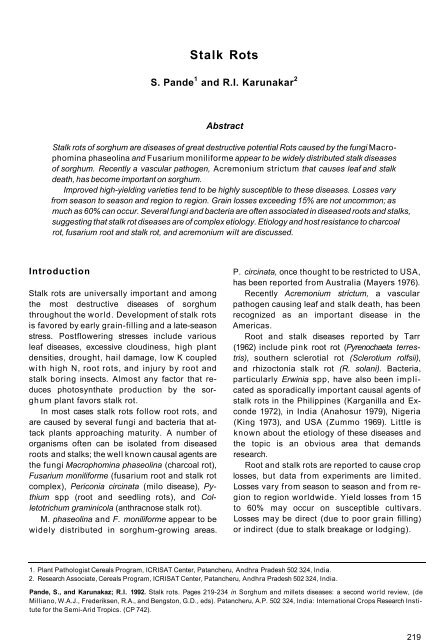Sorghum Diseases in India
Sorghum Diseases in India
Sorghum Diseases in India
Create successful ePaper yourself
Turn your PDF publications into a flip-book with our unique Google optimized e-Paper software.
Stalk Rots<br />
S. Pande 1 and R.I. Karunakar 2<br />
Abstract<br />
Stalk rots of sorghum are diseases of great destructive potential Rots caused by the fungi Macrophom<strong>in</strong>a<br />
phaseol<strong>in</strong>a and Fusarium moniliforme appear to be widely distributed stalk diseases<br />
of sorghum. Recently a vascular pathogen, Acremonium strictum that causes leaf and stalk<br />
death, has become important on sorghum.<br />
Improved high-yield<strong>in</strong>g varieties tend to be highly susceptible to these diseases. Losses vary<br />
from season to season and region to region. Gra<strong>in</strong> losses exceed<strong>in</strong>g 15% are not uncommon; as<br />
much as 60% can occur. Several fungi and bacteria are often associated <strong>in</strong> diseased roots and stalks,<br />
suggest<strong>in</strong>g that stalk rot diseases are of complex etiology. Etiology and host resistance to charcoal<br />
rot, fusarium root and stalk rot, and acremonium wilt are discussed.<br />
Introduction<br />
Stalk rots are universally important and among<br />
the most destructive diseases of sorghum<br />
throughout the world. Development of stalk rots<br />
is favored by early gra<strong>in</strong>-fill<strong>in</strong>g and a late-season<br />
stress. Postflower<strong>in</strong>g stresses <strong>in</strong>clude various<br />
leaf diseases, excessive cloud<strong>in</strong>ess, high plant<br />
densities, drought, hail damage, low K coupled<br />
with high N, root rots, and <strong>in</strong>jury by root and<br />
stalk bor<strong>in</strong>g <strong>in</strong>sects. Almost any factor that reduces<br />
photosynthate production by the sorghum<br />
plant favors stalk rot.<br />
In most cases stalk rots follow root rots, and<br />
are caused by several fungi and bacteria that attack<br />
plants approach<strong>in</strong>g maturity. A number of<br />
organisms often can be isolated from diseased<br />
roots and stalks; the well known causal agents are<br />
the fungi Macrophom<strong>in</strong>a phaseol<strong>in</strong>a (charcoal rot),<br />
Fusarium moniliforme (fusarium root and stalk rot<br />
complex), Periconia circ<strong>in</strong>ata (milo disease), Pythium<br />
spp (root and seedl<strong>in</strong>g rots), and Colletotrichum<br />
gram<strong>in</strong>icola (anthracnose stalk rot).<br />
M. phaseol<strong>in</strong>a and F. moniliforme appear to be<br />
widely distributed <strong>in</strong> sorghum-grow<strong>in</strong>g areas.<br />
P. circ<strong>in</strong>ata, once thought to be restricted to USA,<br />
has been reported from Australia (Mayers 1976).<br />
Recently Acremonium strictum, a vascular<br />
pathogen caus<strong>in</strong>g leaf and stalk death, has been<br />
recognized as an important disease <strong>in</strong> the<br />
Americas.<br />
Root and stalk diseases reported by Tarr<br />
(1962) <strong>in</strong>clude p<strong>in</strong>k root rot (Pyrenochaeta terrestris),<br />
southern sclerotial rot (Sclerotium rolfsii),<br />
and rhizoctonia stalk rot (R. solani). Bacteria,<br />
particularly Erw<strong>in</strong>ia spp, have also been implicated<br />
as sporadically important causal agents of<br />
stalk rots <strong>in</strong> the Philipp<strong>in</strong>es (Karganilla and Exconde<br />
1972), <strong>in</strong> <strong>India</strong> (Anahosur 1979), Nigeria<br />
(K<strong>in</strong>g 1973), and USA (Zummo 1969). Little is<br />
known about the etiology of these diseases and<br />
the topic is an obvious area that demands<br />
research.<br />
Root and stalk rots are reported to cause crop<br />
losses, but data from experiments are limited.<br />
Losses vary from season to season and from region<br />
to region worldwide. Yield losses from 15<br />
to 60% may occur on susceptible cultivars.<br />
Losses may be direct (due to poor gra<strong>in</strong> fill<strong>in</strong>g)<br />
or <strong>in</strong>direct (due to stalk breakage or lodg<strong>in</strong>g).<br />
1. Plant Pathologist Cereals Program, ICRISAT Center, Patancheru, Andhra Pradesh 502 324, <strong>India</strong>.<br />
2. Research Associate, Cereals Program, ICRISAT Center, Patancheru, Andhra Pradesh 502 324, <strong>India</strong>.<br />
Pande, S., and Karunakaz; R.I. 1992. Stalk rots. Pages 219-234 <strong>in</strong> <strong>Sorghum</strong> and millets diseases: a second world review, (de<br />
Milliano, W.A.J., Frederiksen, R.A., and Bengston, G.D., eds). Patancheru, A.P. 502 324, <strong>India</strong>: International Crops Research Institute<br />
for the Semi-Arid Tropics. (CP 742).<br />
219








